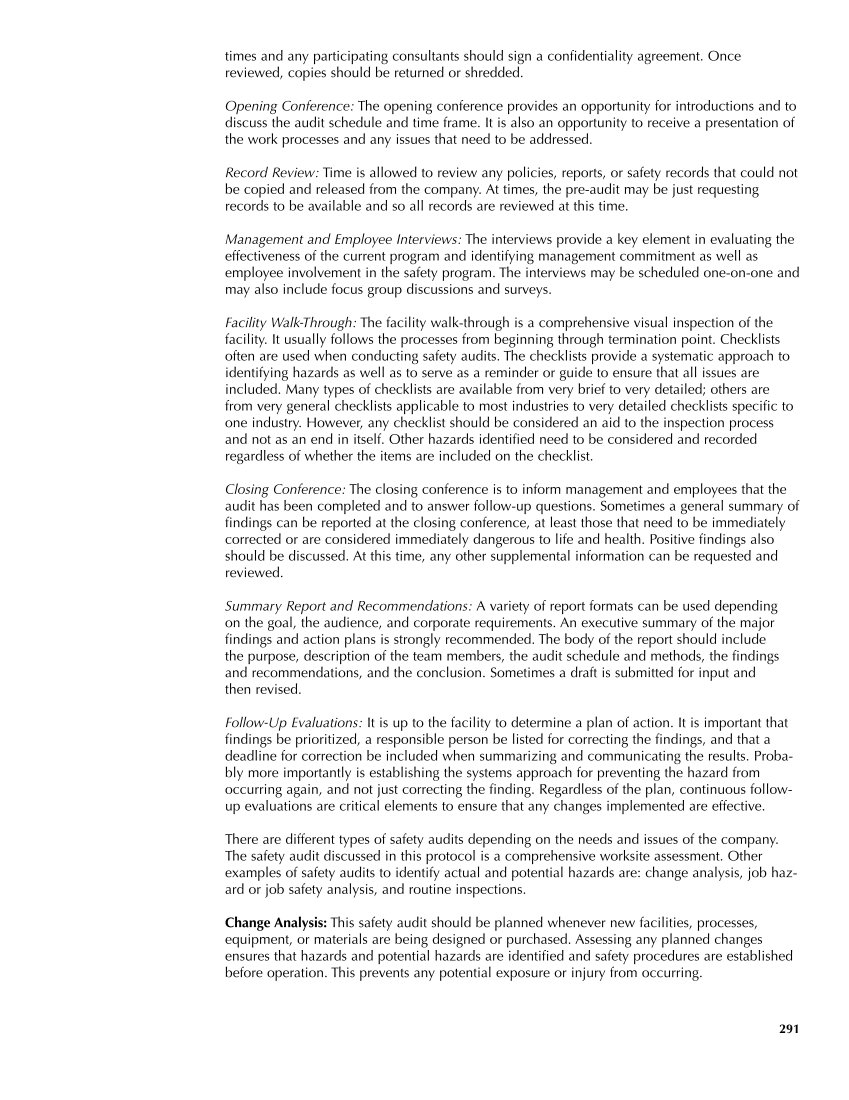times and any participating consultants should sign a confidentiality agreement. Once reviewed, copies should be returned or shredded. Opening Conference: The opening conference provides an opportunity for introductions and to discuss the audit schedule and time frame. It is also an opportunity to receive a presentation of the work processes and any issues that need to be addressed. Record Review: Time is allowed to review any policies, reports, or safety records that could not be copied and released from the company. At times, the pre-audit may be just requesting records to be available and so all records are reviewed at this time. Management and Employee Interviews: The interviews provide a key element in evaluating the effectiveness of the current program and identifying management commitment as well as employee involvement in the safety program. The interviews may be scheduled one-on-one and may also include focus group discussions and surveys. Facility Walk-Through: The facility walk-through is a comprehensive visual inspection of the facility. It usually follows the processes from beginning through termination point. Checklists often are used when conducting safety audits. The checklists provide a systematic approach to identifying hazards as well as to serve as a reminder or guide to ensure that all issues are included. Many types of checklists are available from very brief to very detailed others are from very general checklists applicable to most industries to very detailed checklists specific to one industry. However, any checklist should be considered an aid to the inspection process and not as an end in itself. Other hazards identified need to be considered and recorded regardless of whether the items are included on the checklist. Closing Conference: The closing conference is to inform management and employees that the audit has been completed and to answer follow-up questions. Sometimes a general summary of findings can be reported at the closing conference, at least those that need to be immediately corrected or are considered immediately dangerous to life and health. Positive findings also should be discussed. At this time, any other supplemental information can be requested and reviewed. Summary Report and Recommendations: A variety of report formats can be used depending on the goal, the audience, and corporate requirements. An executive summary of the major findings and action plans is strongly recommended. The body of the report should include the purpose, description of the team members, the audit schedule and methods, the findings and recommendations, and the conclusion. Sometimes a draft is submitted for input and then revised. Follow-Up Evaluations: It is up to the facility to determine a plan of action. It is important that findings be prioritized, a responsible person be listed for correcting the findings, and that a deadline for correction be included when summarizing and communicating the results. Proba- bly more importantly is establishing the systems approach for preventing the hazard from occurring again, and not just correcting the finding. Regardless of the plan, continuous follow- up evaluations are critical elements to ensure that any changes implemented are effective. There are different types of safety audits depending on the needs and issues of the company. The safety audit discussed in this protocol is a comprehensive worksite assessment. Other examples of safety audits to identify actual and potential hazards are: change analysis, job haz- ard or job safety analysis, and routine inspections. Change Analysis: This safety audit should be planned whenever new facilities, processes, equipment, or materials are being designed or purchased. Assessing any planned changes ensures that hazards and potential hazards are identified and safety procedures are established before operation. This prevents any potential exposure or injury from occurring. 291
Purchased from OEM Press by (ge corporate access). (C) 2013 OEM Health Information, Inc. All rights reserved.












































































































































































































































































































































































































































